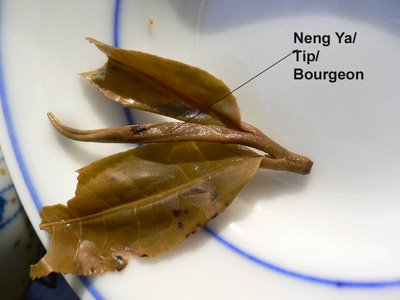Below, you can see a sample of leaves from a Spring 2002 wild raw Yi Wu bing I hope to soon add to my selection. It tastes quite similar to my 2003 wild Yi Wu. The difference is that this one has hardly any 'smoky' smell and therefore tastes completely fruity (young peach). Of course, its young age means there is a little astringency, but not more than the 2003 YiWu.
 I will give you more details about it when I receive the qizi bings. Today, we can first have a look of how I brew it and I'll show you how amazing wild puerh is.
I will give you more details about it when I receive the qizi bings. Today, we can first have a look of how I brew it and I'll show you how amazing wild puerh is.
 SoL was asking yesterday to give more details about how many leaves I put in my gaibei/teapot. Here you can see that the open leaves remain quite low in the gaibei. This volume is actually a little bit more than usual. I could have done with a little bit less leaves.
SoL was asking yesterday to give more details about how many leaves I put in my gaibei/teapot. Here you can see that the open leaves remain quite low in the gaibei. This volume is actually a little bit more than usual. I could have done with a little bit less leaves.I promise I'll buy an electronic weight machine next time I get the opportunity. Then I'll be able to give more scientific answers and to conduct tastings with more rigorous standards.
One of the amazing thing about a wild puerh is the huge size of its tips (compared to other tea varietals). Tips (called neng ya in Chinese and bourgeons in French) are very highly thought of because they are concentrated with fragrance and strength of a future whole leave.

But what's truly amazing with puerh is that one tip will contain other tips! Look at what I found as I unfurled this tip:
 And when I continued to unfurl further, I even found this little tippy in the heart of the leaf. (Some other wild puerhs have even more than 3 tips in one!) Wild puerh trees are believed to develop their tips like this as a defense mechanism, to better protect them from insects and the hardships of their high altitude environment.
And when I continued to unfurl further, I even found this little tippy in the heart of the leaf. (Some other wild puerhs have even more than 3 tips in one!) Wild puerh trees are believed to develop their tips like this as a defense mechanism, to better protect them from insects and the hardships of their high altitude environment.  This shows quite well how puerh is 'wild at heart'. It's thanks to its wild habitat that it has become such a concentrated and fragrant tea. Look at low altitude plantation puerh tips! You'll see that they are smaller and don't contain so many other tips.
This shows quite well how puerh is 'wild at heart'. It's thanks to its wild habitat that it has become such a concentrated and fragrant tea. Look at low altitude plantation puerh tips! You'll see that they are smaller and don't contain so many other tips.







3 comments:
oui, une photo ou une expression imagée vaut mieux qu'une balance électronique !
Personnellement, je préfère ne pas encombrer la table à thé avec des instruments de mesures ; c'est pourquoi j'aime bien retenir les formules imagées, échangées par oral ou par écrit avec mes amis buveurs de thé -il va sans dire que l'unité "sachet" n'a plus cours depuis longtemps chez moi... on compterait plutôt en bourgeons maintenant !
Du Pu ehr sauvage? Et on trouve ça où? Je n'ai jamais vu et suis intéressé.
Il y a du puerh sauvage dans ma sélection. Je conseille le 2003 et le 2006 (bientot). En fait, l'appelation 'sauvage' pour le puerh n'est pas si rare que cela. On en trouve sur Internet, mais la grande partie ne sont pas vraiment sauvage et/ou mélangés avec du puerh de plantation. Les vrais sont rares et chers, car il est en haute montagne plus difficile d'acces pour être recolté.
Post a Comment